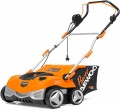Working width
The width of the strip processed by the aerator in one pass. The higher this indicator, the faster the device works, the fewer passes will have to be made to process a certain area. On the other hand,
a wide grip noticeably affects the dimensions of the entire structure and makes it difficult to work in hard-to-reach places, if not impossible. Therefore, when choosing a model in terms of working width, it is worth considering not only the overall dimensions of the site, but also its configuration and the presence of tight areas — sometimes it is preferable to sacrifice the performance of the aerator for the sake of its manoeuvrability and patency.
Max. processing depth
The greatest depth to which the aerator nozzle is able to penetrate the ground during operation.
This parameter is relevant primarily for models that support verticutter functions (see "Type") — the very format of operation of such units implies "biting" into the ground. For scarifiers, the processing depth is often not indicated at all, because. they work mostly above the surface.
Max. processing height
The highest processing height provided by the aerator.
This parameter describes the maximum height above the lawn surface that the working head can be raised to. It is of practical importance only for models with scarifier functions (see "Type"): it is this type of aerator that allows you to leave the space between the working nozzle and the soil surface untouched during operation. This can be useful, for example, when removing debris from a previously fertilized lawn. But in the case of verticutters, the maximum height only affects the convenience of transportation: the higher the nozzle can be raised, the higher obstacles the unit can overcome without hitting it with knives.
Number of depth settings
The number of nozzle depth adjustments provided in the design of the aerator. Note that we can talk not only about the depth, but also, in the case of scarifiers, about the height of processing (for more details, see above). Anyway, the
more depth (height) settings, the wider the choice of the operator, the more accurately he can choose the optimal value for a particular situation.
Working mechanism
The design of the working mechanism provided in the aerator, in other words, the number and types of working elements installed on the shaft. For verticutters (see "Type") such elements are blades, for scarifiers — spring teeth. For
combined models, in this case, the design of both working shafts is indicated, for example "14 knives / 20 spring teeth".
Bag volume
The total volume of the garbage collection bag provided with the aerator.
The larger the bag, the more garbage it can hold, the less often it will have to be emptied. On the other hand, the weight and dimensions of a capacious container will also be considerable (this is especially true for rigid varieties, in which the size does not depend on fullness — see "Bag Type"). Yes, and carrying too much garbage “with you” is not always convenient, especially with the small size and weight of the unit itself. Therefore, manufacturers, usually, choose this parameter taking into account the specifics of the use of the aerator. So, in low-power models designed for small areas, the volume of the bag is also small, and in high-performance professional devices it can exceed 50 liters.
Motor power
The power of the aerator motor, expressed in watts. Today, the watt is the common unit of power and is used for both electric and petrol models (see "Engine type"). In general, the
more powerful the motor, the higher the performance of the unit, the greater the depth of processing and the working width (see above) can be provided in the aerator; however, the consumption of electricity / fuel also directly depends on the power. Therefore, when choosing an engine for their equipment, manufacturers proceed from a reasonable compromise between these properties, and in general, engine power allows you to evaluate the performance of the unit and its suitability for large volumes of work.
Front wheel diameter
One of the parameters on which the diameter of the wheels depends is the weight of the unit: a heavy powerful aerator requires large wheels, and a light model can get by with small ones. In addition, the larger the wheels, the easier they cope with various obstacles, the better the car is suitable for difficult terrain, where you have to move through bumps, stones, etc. However, the downside of such cross-country ability is an increase in the cost of the aerator.
Rear wheel diameter
One of the parameters on which the diameter of the wheels depends is the weight of the unit: a heavy powerful aerator requires large wheels, and a light model can get by with small ones. In addition, the larger the wheels, the easier they cope with various obstacles, the better the car is suitable for difficult terrain, where you have to move through bumps, stones, etc. However, the downside of such cross-country ability is an increase in the cost of the aerator.

